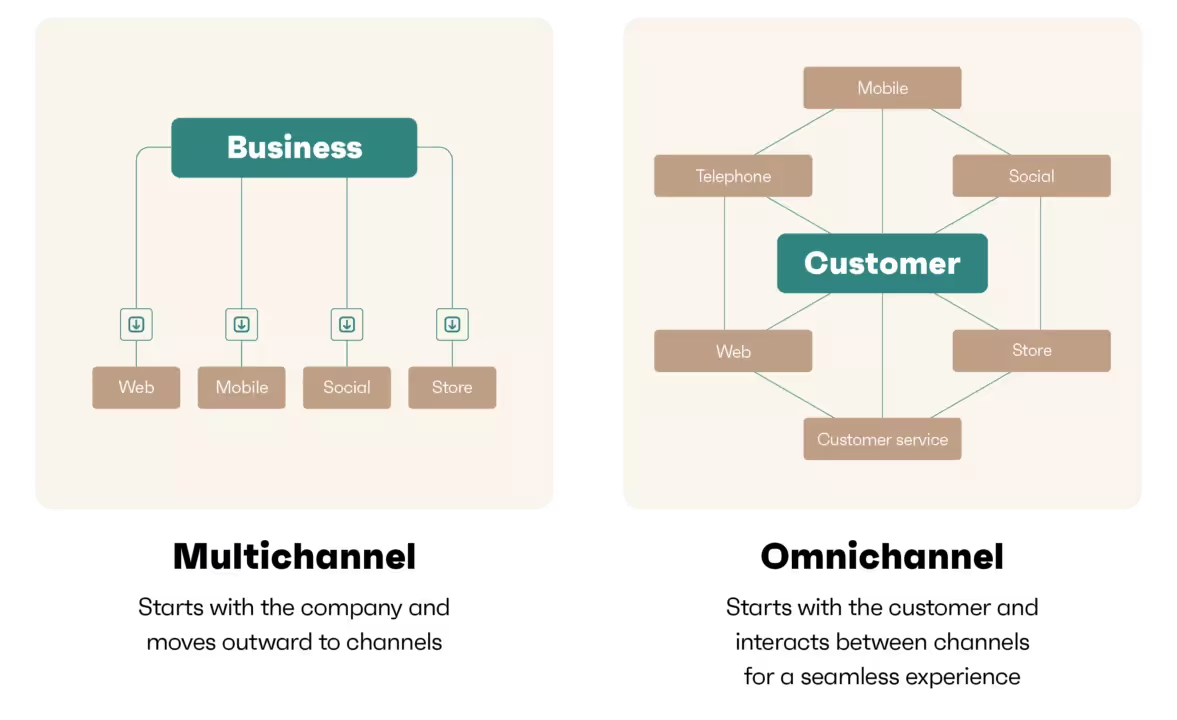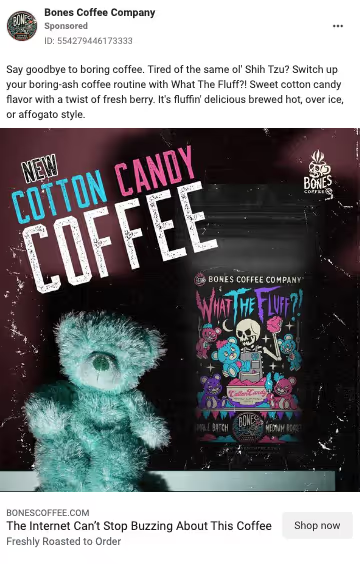It's rare we see a product and head straight for the checkout.
Normal customer journeys have zigs and zags. There's research, decisions over pricing, and even checking out your competitors for a better deal.
eCommerce brands that deploy an omnichannel approach can capture their customer's attention at every stage of their buying journey, from the first touch to post-checkout support. And it pays off—brands using an omnichannel strategy with three or more channels have a 250% higher engagement from customers.
This article will break down the benefits of an omnichannel approach to eCommerce—and how to build a strategy of your own.
Here's what you'll learn in this article:
- What Is An Omnichannel Approach to eCommerce?
- What is the difference between omnichannel and multichannel?
- 4 Huge Benefits Of An Omnichannel Strategy
- How To Implement An eCommerce Omnichannel Strategy
What Is An Omnichannel Approach to eCommerce?
An eCommerce omnichannel marketing strategy is when multiple channels are used at the same time to create a consistent experience for the customer.
Omnichannel commerce offers customer support and a seamless customer experience, no matter if they're on a mobile device or a laptop. Customers can search for products and contact customer support on channels like Twitter, Instagram, WhatsApp or email. Their behavior and communications will be kept in a single place for brands to track.
Omnichannel marketing is effective. Harvard Business Review studied 46,000 shoppers and found those who used more than 4+ channels spent 9% more in the store than the ones who used a single channel.
However, before creating one, marketers must understand the key differences between omnichannel and multichannel strategies.
What is the difference between omnichannel and multichannel?
The difference between omnichannel marketing and multichannel marketing isn't how many channels you're using—it's how you're using them.

Multichannel eCommerce marketing uses several channels, like social media and customer service, to market and talk to customers. But these channels aren't connected and communication is siloed, creating gaps in customer experience.
Omnichannel strategies are different. Each channel is linked to give customers a consistent, seamless experience with your brand no matter how and where they interact with products or customer service.
//[inject:ad-demo]
4 Huge Benefits Of An Omnichannel Strategy
Omnichannel marketing can boost any eCommerce strategy, from better personalization to more loyal customers.
Here are four reasons why an omnichannel strategy is a smart approach 👇
1. Customers have a better experience
Omnichannel strategies help give customers a smoother path from picking a product to getting through the checkout.
It all comes back to customer touchpoints. They may find a product on Instagram or TikTok and then Google it to research customer reviews or to find more information. These are all opportunities for your brand to make a move, from educating the customer to offering exclusive deals and discounts.
An omnichannel strategy allows you to link every channel the customer touches and streamline their entire journey. Not only is this convenient for customers—the improved experience makes it more likely they'll buy something.
2. Sales and traffic can increase
Shoppers love to research items before pulling out their credit cards.
81% of B2C shoppers said they always or often research a product online before making a purchase.
Omnichannel marketing helps make this journey a smooth one. Every channel is linked, so information can flow freely across them without being siloed. When customers are researching products or reaching out to ask questions from your support team, their journey will be uninterrupted.
3. Customers are more loyal
An omnichannel strategy allows brands to meet customers where they're, whether on Twitter or TikTok.
Covering multiple channels means customers can engage with your brand on their own terms. According to one study, omnichannel shoppers interact more with products and are easier to retain. The study also found brands using an omnichannel strategy have 90% higher customer retention rates compared to those with single-channel strategies.
4. More valuable data is collected
Every customer is different—in how they shop, research products and make buying decisions.
This information is vital to creating a successful marketing strategy. An omnichannel approach can cover all bases and track buying behaviors from the first touchpoint to post-checkout support. In addition to collecting data on which marketing channels and campaigns are most engaging, brands can also gather customer feedback, A/B tests, and KPIs under one roof.
How To Implement An eCommerce Omnichannel Strategy
Slowly but surely, eCommerce brands are moving away from siloed strategies and pivoting to an omnichannel approach.
According to HubSpot, 91% of retailers and brands plan to invest in an omnichannel strategy to improve customer experience and overall revenue. However, these strategies aren't built overnight. A successful eCommerce omnichannel approach requires careful customer research and attention at every touchpoint.
Here's how to build and implement an eCommerce omnichannel strategy that drives customers—and sales 👇
Step 1: Figure out what your customers (really) want
Research your current customers and target audiences to see what marketing channels make sense to focus on.
Brands can fall into the trap of activating every social media and marketing channel available, but it only makes sense to invest in channels your customers actually use.
Start by looking at metrics and tracking engagement to see which of your current channels are seeing the most engagement. You can even survey customers and ask for feedback about what channels they prefer to reach out to you on.
Check out how Sightglass Coffee asks customers for input:

We love this email because it's simple and has a clear ask: the brand wants its customer's input. The survey can then ask customers if they prefer customer support over text or chatbot or if marketing emails and communications are sent out at a comfortable frequency.
Step 2: Personalize every campaign, ad and message
Customers don't just want personalization—they expect it.
Make an effort to personalize your campaigns and ads—and the payoff can be huge. According to one HubSpot study, adding personalized calls to action (CTAs) boosted conversion by 202%. However, that doesn't mean you should sleep on an omnichannel marketing strategy's huge range of opportunities.
Using segments or tags when collecting contact information allows you to store details about your customers and their buying behaviors. This information can then be used to create retargeting campaigns on social media and email channels if they don't buy something from you on their first visit. Details you want to focus on are:
- Personal: The customer's age, gender, demographics and location
- Customer journey: Are they close to purchasing or still at the top of your funnel? You should track when they visited your website, what they viewed, and if they reached the checkout.
- Interest: How often the customer has interacted with your products/website and what channels they're using channels
These details are a goldmine for creating personalized campaigns across multiple different channels.
Take this example from Bones Coffee Company. Customers who have signed up to the company's email list or have purchased flavored coffee are targeted with new flavor releases over email:

The company also spreads the word using targeted ads on platforms like Facebook and Instagram.

Using custom tags and images, you can ensure every email and social media ad speaks directly to the preferences of its customer base. The best part about these personalized campaigns is that omnichannel marketing tools can do the hard work for you.
//[inject:ad-ebook-omnichannel-strategies]
Step 3. Keep your brand consistent and easily recognizable
The tone of voice and branding should be consistent across all channels to ensure a seamless shopping experience for your customers.
Maintaining brand consistency across each platform in your omnichannel strategy can increase revenue by up to 23%. And the reason is simple—customers love brands they immediately recognize. But a successful omnichannel strategy requires buy-in from your entire team, from marketing to customer support and everyone in-between.
As Marty Neumeier, author of The Brand Gap, reminds us, branding is more than just a consistent logo.
“A brand is not an identity. A brand is not a product. A brand is a person’s gut feeling about a product, service, or organization.”
Look at how clothing giant Sephora does it. First, their app is instantly recognizable as the same font and color palate is used on their website and social media channels:

That consistency flows into Sephora's other social media channels. Check out their Instagram and TikTok:

The branding is identical and instantly recognizable as Sephora. This is a great example of a successful omnichannel marketing approach—each channel works with the other, not against it.
Step 4: Track customer behavior and switch up your strategy (if needed)
Finally, always track engagement with your strategy and switch it up if your customer's buying behavior changes.
Every social media channel has inbuilt analytics that tracks what posts are popular and how much customers are engaging with them. Use this same approach with your email and customer support data. Track which campaigns are landing with customers, and if they are starting to engage more with a certain channel, don't be afraid to put more effort and resources where they are.
Omnichannel marketing strategies meet customers where they are
Online or in-store, customers want a positive shopping experience.
An omnichannel marketing strategy helps you meet customers at the right time on their buying journey. Whether they're interacting with your brand over chatbot, email or Instagram, an omnichannel approach allows you to cover all bases so customers never fall through the cracks.
By catching customers at the right time and on the right channel, brands can build loyalty and trust—and increase sales.



%20(1).avif)




%20(1).avif)
%20(1).png)
.avif)


.avif)
.avif)


.avif)





.avif)



.avif)





.avif)


.avif)

.avif)
.avif)

.avif)
.avif)

.avif)

.avif)


.avif)
.avif)
%20(1).avif)
.avif)









.avif)











.avif)
.avif)

%20(1).avif)

%20(1).avif)



.avif)


























.avif)











































.avif)



.avif)




























.avif)



.avif)

.avif)

.avif)
.avif)


.avif)













.avif)

.avif)










.avif)












.avif)






































.avif)



.avif)

.avif)

.avif)
.avif)

.avif)
.avif)

.avif)

.avif)

.avif)

























